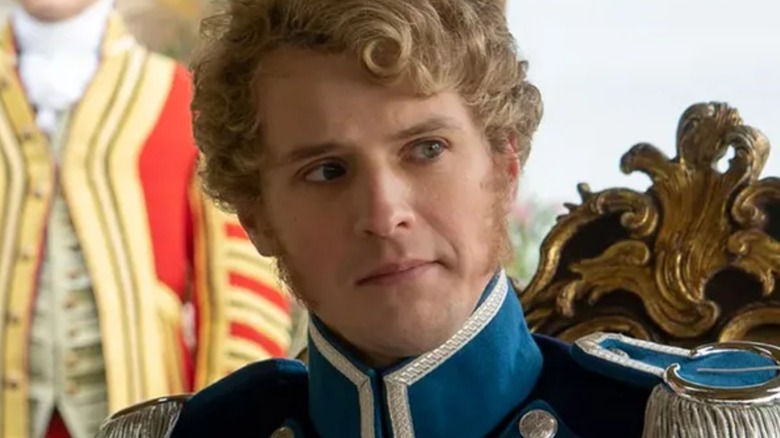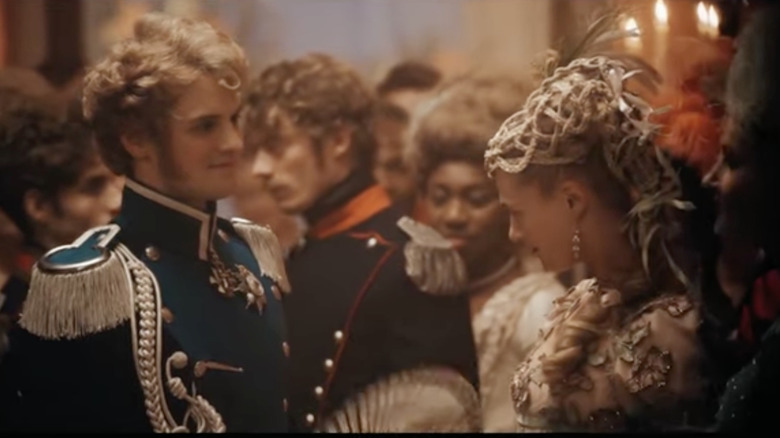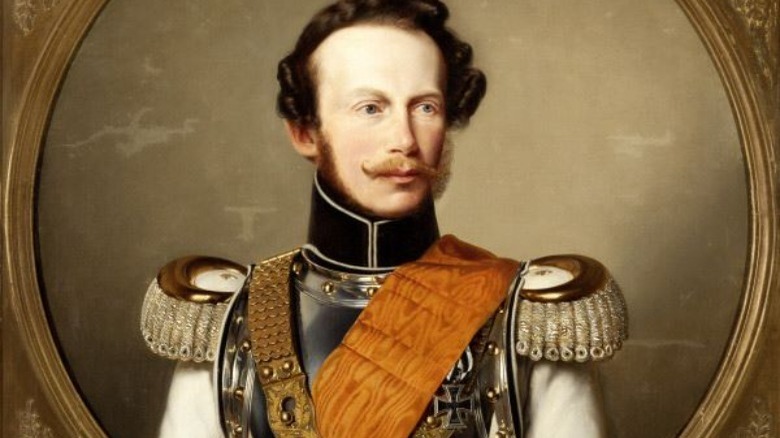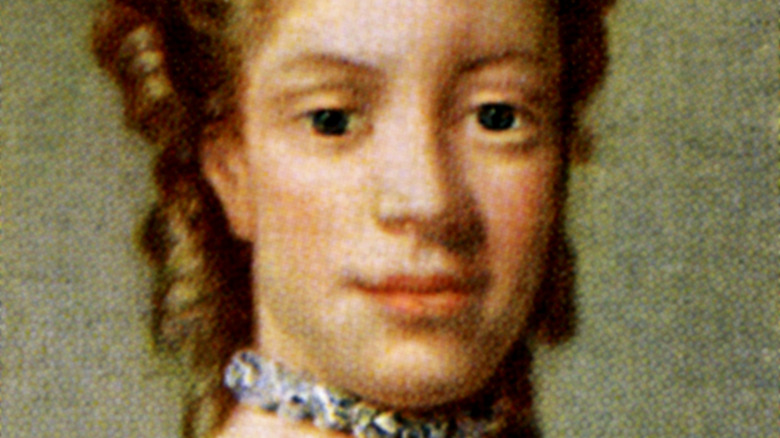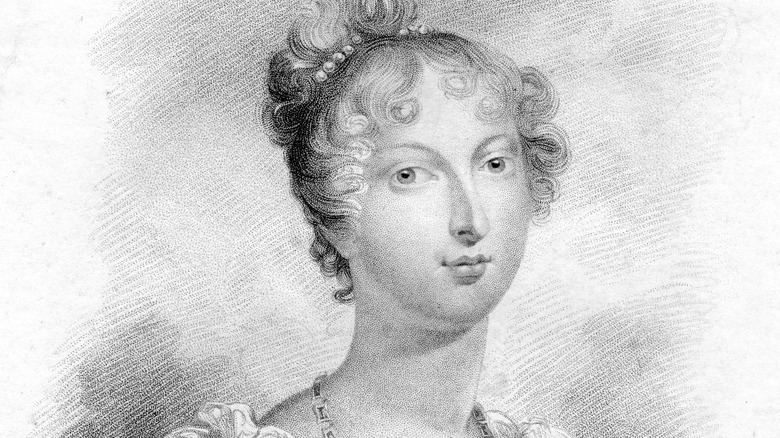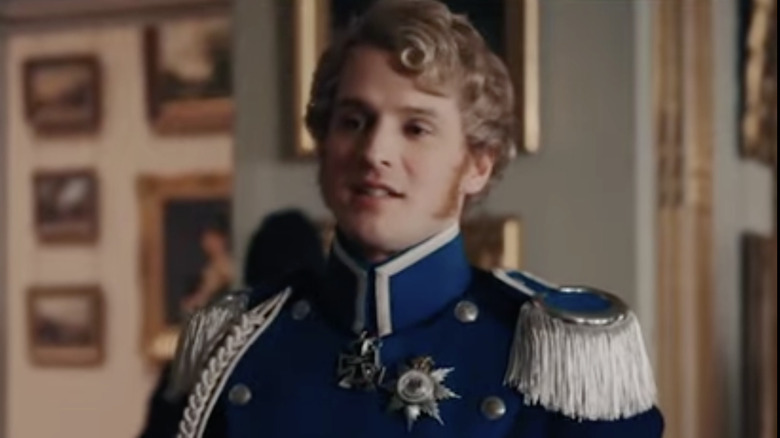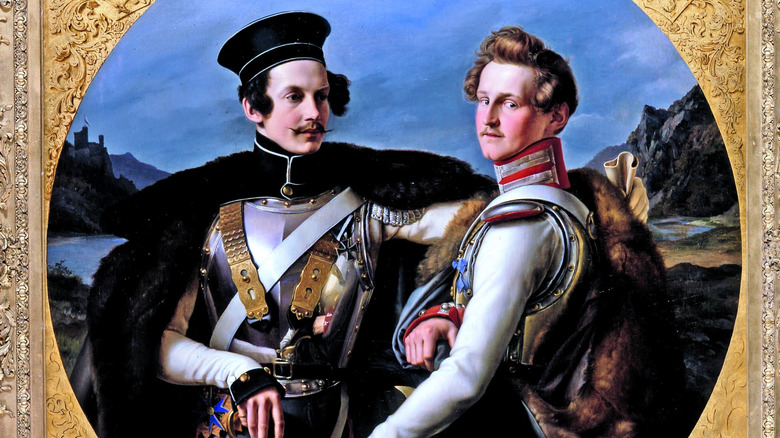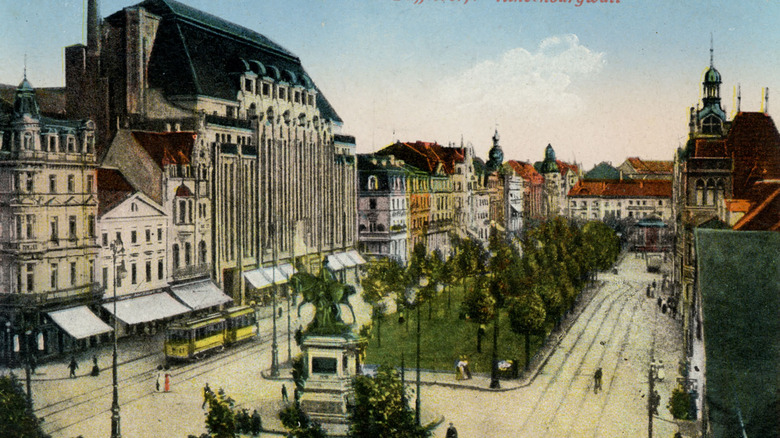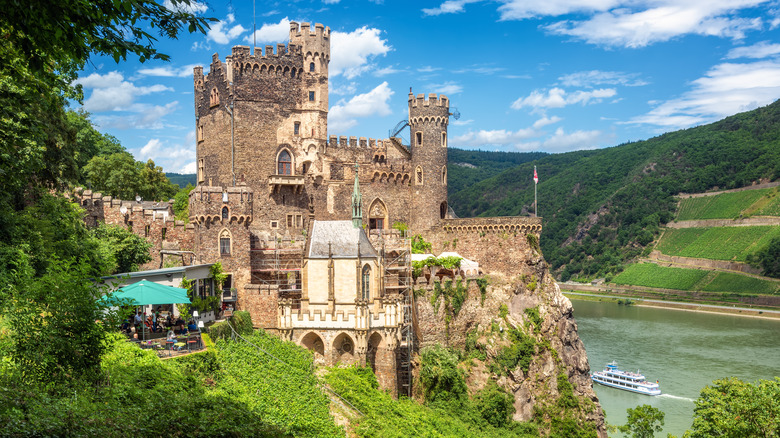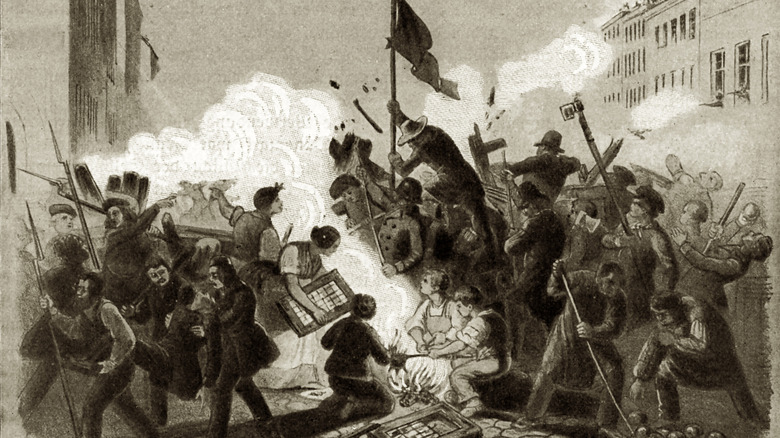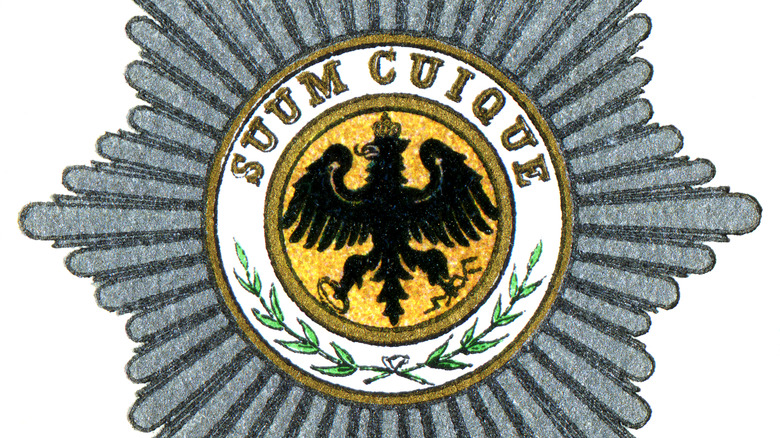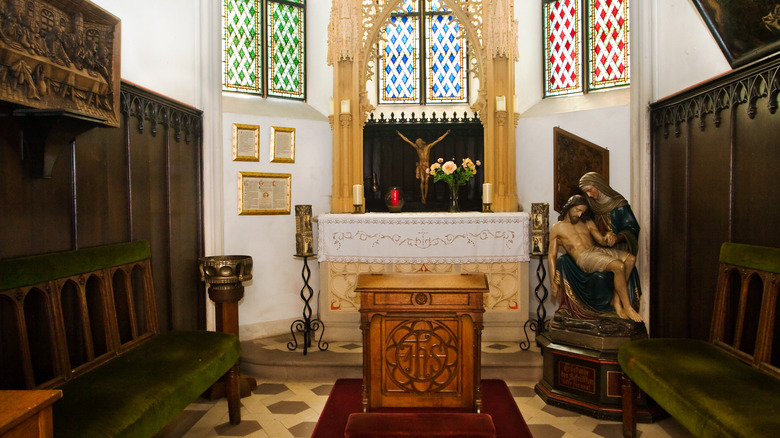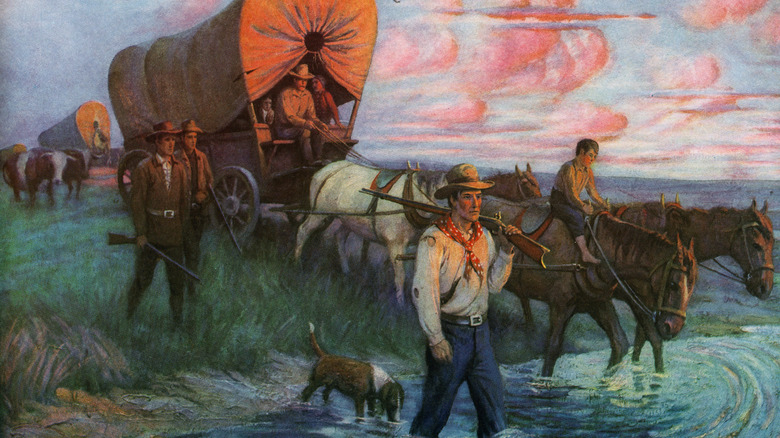The Real-Life Story Of Bridgerton's Prince Frederick Of Prussia
There's nothing like a love triangle to ratchet up the action of a historical romance. A properly written three-way love match creates jealousy, confusion, and plenty of sexual tension. Consider how Edward Rochester uses a potential engagement to Blanche Ingram to awaken Jane Eyre's jealousy and passion for him. Or how Elizabeth Bennett's admiration of George Wickham infuriates Fitzwilliam Darcy while forcing him to come to terms with his true feelings.
We find the same trend in season one of Netflix's "Bridgerton," where Daphne Bridgerton finds herself a potential love interest for two different men simultaneously. On the one hand, there's Simon Basset, the mysterious Duke of Hastings with a lot of baggage and drop-dead good looks. He appears too busy settling his father's affairs to get involved in a romantic relationship, but that doesn't stop him from eventually falling for Bridgerton.
But there's also Frederick of Prussia, an impossibly blond and debonair nice guy who has everything going for him. Yet, he inadvertently helps Daphne win the heart of the Duke of Hastings through jealousy. Interestingly, Prince Frederick of Prussia was an actual historical figure. If you're looking to "Bridgerton" to tell his story accurately, think twice. There are plenty of historical inaccuracies when it comes to his portrayal. Here's what you need to know.
Bridgerton's Prince Frederick of Prussia
There's a lot to love about Prince Frederick of Prussia as he's portrayed in "Bridgerton." Not only is he cute and well-mannered, but he's portrayed as the blue blood nephew of Queen Charlotte. Because of his squeaky-clean good looks, noble upbringing, and heroic military career as a member of the Royal Cavalry, Frederick of Prussia must deal with a slew of debutantes who throw themselves at his feet.
Of course, as any good love triangle goes, Frederick ends up pursuing the one woman, Daphne Bridgerton, who's not that interested. Bridgerton's heart has already been stolen by the Duke of Hastings (even if she won't admit it). Some fans would have preferred to see her make the safe choice by going after the Queen's nephew (via Slate). After all, Frederick is portrayed as downright perfect — along with being a boring open book.
His virtues go beyond merely playing the nice guy. He also displays genuine kindness, which is a trait you don't typically see in the guy that doesn't get the girl. Slate claims this trait, kindness, is the most interesting thing about him, and we can get behind this argument. That said, when you compare this portrayal to the real-life Prince of Prussia, the differences are pronounced.
Prince Frederick was young for the Bridgerton crew
Many fans agree that Prince Frederick William Louis of Prussia makes a nice addition to the cast of "Bridgerton," per Slate. The advent of his character moves the principal storyline along while acting as a literary foil for the Duke of Hastings. He also provides an excellent dose of eye candy for a show that takes great pride in pageantry, vibrant period costumes, and a gorgeous cast.
Unfortunately, there's a significant problem with the historical accuracy of his introduction. The real-life prince was born in 1794, according to Sotheby's. So, when "Bridgerton" takes place in 1803, Frederick was just nine years old and living in Berlin, Germany. (At that time, it was a part of the Kingdom of Prussia.)
Yes, he proved a handsome and debonair man distinguished by a long, celebrated, and successful military career. He also was one of Europe's most eligible bachelors for a time, but he hadn't achieved any of this at the age of nine. What's more, the bulk of the events of the historical guy's life transpired during the Victorian era rather than the Regency period.
He enjoyed a royal pedigree
Like his character in "Bridgerton," Prince Frederick of Prussia came from noble lineage. He was the son of Prince Louis Charles of Prussia and Duchess Frederica of Mecklenburg-Strelitz, according to Sotheby's.
His mother eventually became the Queen of Hanover, and Prince Frederick also boasted status as the stepson of Ernest Augustus, King of Hanover, and nephew of King Frederick William III of Prussia. Duchess Frederica was the niece and daughter-in-law of Queen Charlotte, having married Ernest Augustus, Charlotte's eighth child.
Not only does this genealogy demonstrate just how inbred Europe's nobility remained during this period, but it also points to the fact that Prince Frederick of Prussia was the great-nephew, rather than nephew, of Queen Charlotte. Again, this stems back to his historical versus fictional age and the time-traveling trick that "Bridgeton" plays on viewers in their presentation of the golden-haired suitor.
The real Prince kept his romantic entanglements under wraps
In "Bridgerton," Prince Frederick represents the romantic adversary of the Duke of Hastings in his attempt to win the hand of Daphne Bridgerton. His real-life romances also proved fascinating. In fact, you could say the prince got involved in his own love triangle. Many thought he'd formed an attachment with Princess Charlotte of Wales, the granddaughter of King George III and Queen Charlotte, in 1814.
According to the Tatler, Princess Charlotte wanted to keep her options open, though. Not only did she entertain Prince Frederick, but she also attracted the attention of two other German princes: Augustus of Prussia and Leopold of Saxe-Coburg-Saalfeld. Of the three German princes, it appears Frederick proved her favorite as attested by letters to close confidantes where she often spoke of a man identified only as "F," per Anne Stott's "The Lost Queen: The Life and Tragedy of the Prince Regent's Daughter."
Some say she even broke an engagement with another man in 1814 to make way for the gorgeous Teutonic prince. Secret correspondence between the two also demonstrates her interest in him. Nevertheless, she hedged her bets by keeping the other two princes in reserve. Prince Frederick never proposed to Charlotte, eventually marrying Princess Louise (Luise) Augusta of Anhalt-Bernburg in 1817 instead (via Oprah Daily).
His line ended with his sons
Prince Frederick of Prussia and Princess Louise of Anhalt-Bernburg married in 1817, and their marriage produced two sons, as reported by Oprah Daily. While Frederick and Louise's sons, Prince Alexander and Prince George (both of Prussia), enjoyed long lives, neither married nor had children.
On January 5, 1896, The New York Times ran an obituary for Prince Alexander of Prussia. The announcement explains that Alexander died at the age of 75 after a long illness. Like his father, he served in the Prussian military as a General of infantry before his passing. Born in Berlin on June 21, 1820, he also received recognition as Chief of the Third Westphalia Infantry Regiment. Other noteworthy titles included Knight of the Black Eagle and the Guard in the Landwehr's Chief of the Second Regiment of Grenadiers. What's more, he fought in the Austro-Prussian War of 1866, as reported by "The Annual Register of World Events: A Review of the Year" (Volume 138) edited by Edmund Burke.
Prince George of Prussia also served with distinction in the military, as reported by The New York Times. Born on February 12, 1826, he proved a man of many talents as a poet and playwright who wrote under the pen names of George Conrad and Gunther von Freiberg (via The Online Portrait Gallery). Securing his family's line would elude Prince Frederick. Although Alexander and George both lived long lives, neither son extended the bloodline with an heir.
Prince Frederick served in the military
Like his ancestors before him, Prince Frederick of Prussia served in the military as the Commander of the 1st Life Cuirassiers, a Royal Prussian Army regiment, per Screen Rant. This position meant that he led a somewhat rootless life with plenty of travel. In season one of "Bridgerton," the show alludes to his distinguished military service and heavy traveling.
Prince Frederick's military service doesn't come as a surprise to anyone familiar with the Prussian military tradition, per Robert M. Citino's "Death of the Wehrmacht." These roots extend all the way back to the 17th century when Frederick William (a.k.a. the Great Elector) assembled 5,000 soldiers to create the region's first standing royal army, according to Peter Wilson's "Absolutism in Central Europe."
According to Gillian Wagner's "Miss Palmer's Diary: The Secret Journals of a Victorian Lady," the real-life Prince Frederick of Prussia relocated in 1820 to Jägerhof Castle in Düsseldorf to fulfill his military duties. All told, he led the cavalry for an impressive five decades. Pride in his military service extended to representations of him in art as exemplified in the double portrait of Prince Frederick and his half-brother Prince Wilhelm of Solms-Braunfels from 1830, according to Tomasso Brothers (12). Created by artist Friedrich Wilhelm Schadow, the composition emphasizes their roles as military men and defenders of Prussia.
Crafting a social and political life in Düsseldorf
After Prince Frederick and Princess Louise relocated to Jägerhof Castle in Düsseldorf, the couple created a vibrant cultural and social life, as reported by Gillian Wagner's "Miss Palmer's Diary: The Secret Journals of a Victorian Lady." By 1822, Frederick reorganized the Academy of Painting, an institution founded by the 18th-century prince Charles Theodore, transforming it into a prospering institution (via Encyclopedia Britannica).
When Johann Gottfried Schadow painted the portraits of Prince Frederick and Prince Wilhelm, he worked as the director of Düsseldorf's Academy of Art, according to the Tomasso Brothers (12). What's more, it represents just one of the many masterpieces commissioned by Frederick of Prussia to support the local arts scene.
Prince Frederick and Princess Louise would live at Jägerhof Castle through 1848, enthusiastically encouraging cultural activities. Over the course of those years, they emerged as leading collectors and patrons of the German arts and fulfilled an important role in promoting German Romanticism.
He restored his own fairy tale castle
The 19th century ushered in Romanticism and its fixation on the mysticism and myths of the Middle Ages, as reported by the University of Houston. Prince Frederick of Prussia caught the medieval fever, acquiring the 14th-century ruins of Vautsberg (Fatzberg) Castle in 1823 (via Outdoor Active). By 1825, he had the ruins renovated to function as a summer residence.
Next, he constructed Burg Rheinstein on the site, which marked the first castle of what would become known as the Rheinromantik era. Construction was completed in 1829, and he spared no expense when it came to crafting a romantic ambiance, per the castle's official website. The property includes impressive frescoes, a Renaissance fireplace, stained glass windows, and period furniture.
He commissioned a castle garden still prized as one of the finest to be seen in the Middle Rhine. Built on a steep slope, Rheinstein Castle affords expansive views of the Rhine Valley and Bingen Forest. It represented a sublime retreat and the perfect location to get away from his military and political responsibilities. What's more, it inspired a trend along the Rhine by nobility to reconstruct medieval castles damaged during past conflicts such as the Thirty Years' War.
Prince Frederick participated in the Revolutions of 1848
As the leader of the Royal Cavalry of Prussia for nearly five decades, Prince Frederick of Prussia became embroiled in various military engagements by default, including the Revolutions of 1848. Originating in Sicily, these revolutions marked part of a broader sweeping movement that impacted much of the European continent, according to Britannica.
In Germany, they emphasized pan-Germanism and relentlessly critiqued the autocratic political setup of the 39 states of the German Confederation. Standing in opposition to the revolutionaries was Frederick of Prussia's cousin, King Frederick William of Prussia. Inspired by events in France in the preceding months, the revolutionaries soon contributed to open fighting and violence in the streets of Berlin. In the aftermath of the conflict, Frederick of Prussia's cousin made concessions, promising that "Prussia is henceforth merged in Germany" (via Britannica).
Prince Frederick and his cousin King Frederick William had lived long enough to see Germanic nobility dissolving beneath the weight of nationalism and populism. Teutonic aristocrats like Frederick and his cousin began to increasingly look like artifacts of a celebrated but obsolete past as the Germanic states progressed from feudalism towards capitalism and socialism, according to Ohio University.
He proved highly and internationally decorated
Throughout his life, Prince Frederick enjoyed countless medals and honorary inductions into various orders, as recorded in Prussia's "State Calendar for 1862 through 1863." These included receiving the Knight of the Black Eagle, per the "List of the Knights of the Royal Prussian High Order of the Black Eagle."
As a member of the Order of the Black Eagle, Frederick of Prussia enjoyed the highest military honor bestowed by Prussia and one requiring "blind obedience and steadfastness in the face of death" (via C. B. A. Behrens' "Society, Government, and the Enlightenment: The Experiences of 18th-Century France and Prussia").
Other honors he boasted were the Grand Commander's Cross of the Royal House of Hohenzollern created in 1841 to denote extraordinary merit, as reported by The Regalia Specialist. The Grand Commander's Cross even outranked the Iron Cross although Frederick of Prussia had one of those from the Kingdom of Prussia, too. Finally, he received honors from the Grand Duchy of Oldenburg and the Russian Empire, including the Knight of the White Eagle inspired by the Polish national symbol that once denoted the nobility's right to rule (via the University of Buffalo).
Prince Frederick's final burial place
Between 1839 and 1844, Prince Frederick of Prussia had an impressive neo-Gothic chapel built on the grounds of Rheinstein Castle, according to Outdoor Active. Located south of the castle, the chapel sits outside the castle's ring wall, which dates to the Middle Ages.
It features an elaborate gable facade with finial adornments on the roof along with dragon-shaped gargoyles. Frederick took great care in the design and construction of this chapel because he wanted to be interred in his favorite location. Following his death in 1863, he was buried beneath the chapel in a family crypt. Accompanying him in the crypt are the coffins of his wife, Princess Louise, and his younger son, George.
A staircase located outside the chapel leads visitors to a small window where they can see into the crypt. From the crypt, a steep path leads back to the castle following the banks of the Rhine. On the climb back to the castle, guests see waterfalls and a human-made stream, a landscape ingeniously constructed to appear rugged and untamed, a fitting nod to the 19th-century romanticism that Frederick embraced throughout his lifetime.
The Prince's Texas connection
Besides the attention Prince Frederick of Prussia has received as a fictional character in "Bridgerton," he's got a surprising legacy in the Lone Star state, according to the City of Fredericksburg, Texas. John O. Meusebach founded Fredericksburg (a.k.a. Friedrichsburg) in Texas in 1846, naming it in honor of Prince Frederick of Prussia.
If you're wondering how Prince Frederick made such an impression in the Wild West, it had to do with his role in the Adelsverein, as reported by Texas Hill Country. Also known as the Society for the Protection of German Immigrants in Texas, the Adelsverein proved instrumental in assisting German immigrants in relocating to the United States. Frederick of Prussia served as the highest member of this group.
Fredericksburg, Texas, represented the second of two settlements created for Germanic settlers, and it was carefully selected for its natural resources, which included a well-forested region located between Town Creeks and Barton. This townsite offered those who relocated the supplies necessary to get established. Many of these Teutonic immigrants came from liberal, well-educated backgrounds, and it made sense to them to dedicate their new lives to the Germanic aristocrat that helped them get there.
